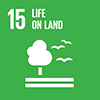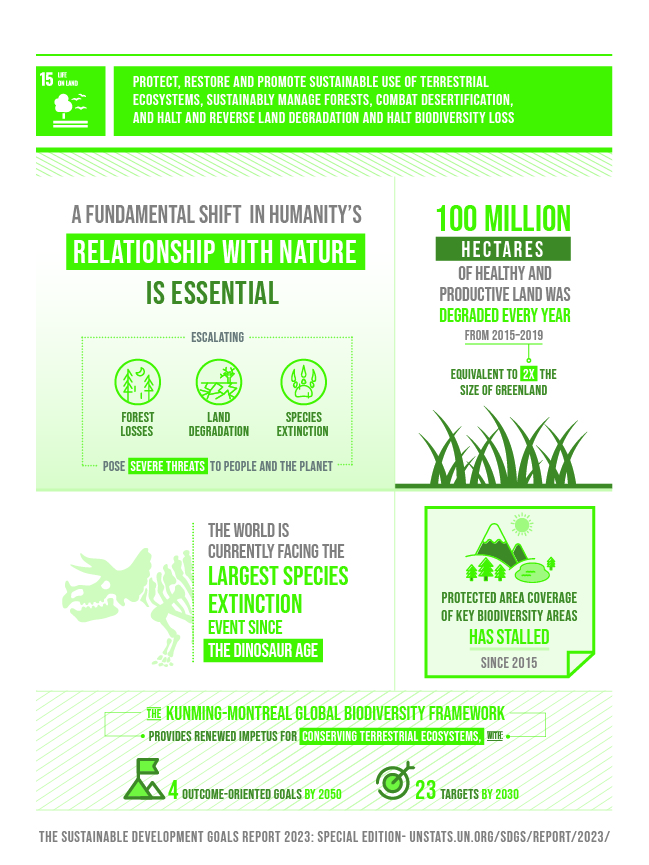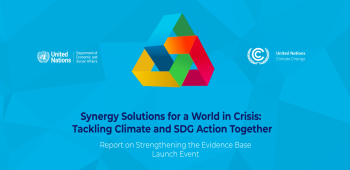
Biodiversity and ecosystems

Desertification, land degradation and drought
Overview
Targets and Indicators

15.1
By 2020, ensure the conservation, restoration and sustainable use of terrestrial and inland freshwater ecosystems and their services, in particular forests, wetlands, mountains and drylands, in line with obligations under international agreements
15.1.1
15.1.2

15.2
By 2020, promote the implementation of sustainable management of all types of forests, halt deforestation, restore degraded forests and substantially increase afforestation and reforestation globally
15.2.1

15.3
By 2030, combat desertification, restore degraded land and soil, including land affected by desertification, drought and floods, and strive to achieve a land degradation-neutral world
15.3.1

15.4
By 2030, ensure the conservation of mountain ecosystems, including their biodiversity, in order to enhance their capacity to provide benefits that are essential for sustainable development
15.4.1
15.4.2

15.5
Take urgent and significant action to reduce the degradation of natural habitats, halt the loss of biodiversity and, by 2020, protect and prevent the extinction of threatened species
15.5.1

15.6
Promote fair and equitable sharing of the benefits arising from the utilization of genetic resources and promote appropriate access to such resources, as internationally agreed
15.6.1

15.7
Take urgent action to end poaching and trafficking of protected species of flora and fauna and address both demand and supply of illegal wildlife products
15.7.1

15.8
By 2020, introduce measures to prevent the introduction and significantly reduce the impact of invasive alien species on land and water ecosystems and control or eradicate the priority species
15.8.1

15.9
By 2020, integrate ecosystem and biodiversity values into national and local planning, development processes, poverty reduction strategies and accounts
15.9.1
(a) Number of countries that have established national targets in accordance with or similar to Aichi Biodiversity Target 2 of the Strategic Plan for Biodiversity 2011–2020 in their national biodiversity strategy and action plans and the progress reported towards these targets; and (b) integration of biodiversity into national accounting and reporting systems, defined as implementation of the System of Environmental-Economic Accounting

15.a
Mobilize and significantly increase financial resources from all sources to conserve and sustainably use biodiversity and ecosystems
15.a.1
(a) Official development assistance on conservation and sustainable use of biodiversity; and (b) revenue generated and finance mobilized from biodiversity-relevant economic instruments

15.b
Mobilize significant resources from all sources and at all levels to finance sustainable forest management and provide adequate incentives to developing countries to advance such management, including for conservation and reforestation
15.b.1
(a) Official development assistance on conservation and sustainable use of biodiversity; and (b) revenue generated and finance mobilized from biodiversity-relevant economic instruments

15.c
Enhance global support for efforts to combat poaching and trafficking of protected species, including by increasing the capacity of local communities to pursue sustainable livelihood opportunities
15.c.1
Progress and Info
Global forest cover is shrinking, conservation of key biodiversity areas has stalled, and species extinction is accelerating. Desertification, land and soil degradation, drought and deforestation are further threatening ecosystems and development prospects. While more countries are adopting legal frameworks for biodiversity and environmental protection, overall progress on Goal 15 remains slow, with significant gaps in safeguarding healthy land and ecosystems vital to humanity. The conferences of the Parties to the United Nations Convention to Combat Desertification in Those Countries Experiencing Serious Drought and/or Desertification, Particularly in Africa and to the Convention on Biological Diversity have helped to mobilize resources and advance global objectives to support conservation and restoration, sustainable forest management and nature-based solutions that promote resilience, livelihoods and inclusion. The Kunming-Montreal Global Biodiversity Framework, adopted in 2022, has renewed momentum for implementation.
Targets 15.1 and 15.2 - Global forest area continues to decline, although at a slower rate than in previous decades. The proportion of forest cover to total land area decreased from 31.9 per cent in 2000 to 31.2 per cent in 2020. However, sustainable forest management is improving, with an increase in the proportion of forests under management plans and within protected areas.
Targets 14.5, 15.1 and 15.4 - Globally, average protection of key biodiversity areas increased from approximately 25 per cent in 2000 to approximately 44 per cent in 2024 across marine, terrestrial, freshwater and mountain biomes. However, progress has largely stagnated since 2015.
Target 15.5 - Changes in aggregate species’ extinction risk, measured using the International Union for Conservation of Nature Red List Index, show a deterioration of greater than 12 per cent from 1993 to 2024 (and 4 per cent since 2015). The most severe deterioration is seen in Central and Southern Asia and Eastern and South-eastern Asia.
Target 15.6 - As at 2024, 76 countries (up from 5 countries in 2015) and 97 countries (up from 12 countries in 2015) reported about their legislative, administrative or policy measures under the Nagoya Protocol on Access to Genetic Resources and the Fair and Equitable Sharing of Benefits Arising from Their Utilization to the Convention on Biological Diversity and the International Treaty on Plant Genetic Resources for Food and Agriculture, respectively.
Target 15.9 - Country implementation of the international statistical standard to measure the environment and ecosystems and their connection to the economy increased by 36 per cent from 2017 to 2024. Although growth has slowed in recent years, adoption is expected to rise, as the standard supports key indicators in the Kunming-Montreal Global Biodiversity Framework.








